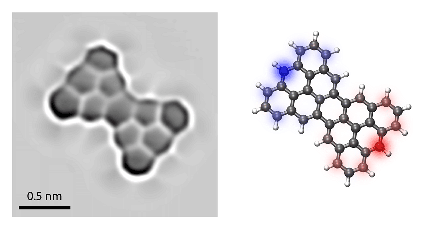Scientists have developed a theoretical model of quantum physics using graphene "Lego."
The smallest unit of information in a computer, a bit, can be in an "on" or "off" state, representing either one or zero. Quantum computers have their own version of a bit called a qubit. It also has two fundamental states, but quantum effects allow it to exist in a superposition of these states. This means that a qubit can simultaneously represent both one and zero in various proportions, theoretically enabling it to take on an infinite number of states.
One method of encoding the states "0" and "1" in a qubit utilizes the orientation of an electron's spin. Spin is a fundamental quantum-mechanical property of particles, which can be thought of as a kind of rotation pointing "up" (corresponding to one) or "down" (zero).
During quantum-mechanical interactions, spins begin to influence each other's states: changing the orientation of one will affect all connected spins. This is a way for qubits to "communicate" with one another. While it can be described mathematically, finding an exact solution for the equations needed to describe the system is practically impossible, even for relatively simple chains of a few spins.
European researchers employed a "quantum constructor" to demonstrate a well-known theoretical model of quantum physics. Staff members from the Empa nanotech@surfaces laboratory (Switzerland) developed a method to control the "communication" of many spins and "listen in" on their interactions. Together with scientists from the International Nanotechnology Laboratory of Iberia (Portugal) and the Technical University of Dresden (Germany), they succeeded in creating a model of a chain of electron spins on graphene and measuring its properties in detail.
The basic theory of spin interaction is straightforward: in a chain of spins, each spin strongly interacts with one neighbor and weakly with another. This is the one-dimensional alternating Heisenberg model. In nature, there are materials with spin chains, but they have not yet been successfully integrated into a material intentionally.
To create an artificial quantum material, the researchers used small fragments of graphene, each consisting of fewer than 50 carbon atoms. For the selected nanographene molecules, shape significantly influences their physical properties, especially their spin. Each fragment acted as a kind of nanoscale quantum "Lego piece," allowing the scientists to assemble long chains from these pieces.

For their implementation of the Heisenberg model, the researchers used a molecule known as "Clara's bowl." It consists of 11 carbon rings arranged in an hourglass shape. This shape provides an unpaired electron with its spin at each end. Although chemist Erich Klar predicted the existence of such a molecule back in 1972, it was only synthesized in 2019 by Roman Fasel's team (Roman Fasel) at the Empa nanotech@surfaces laboratory.
The researchers connected graphene "Clara's bowls" into chains on a gold surface. The two spins at the ends of each molecule are weakly coupled to each other, while the spins belonging to different molecules are strongly coupled—this is the ideal realization of an alternating Heisenberg chain.

As a result, the scientists were able to precisely control the length of the chains, selectively turn individual spins on and off, and change their states. This enabled a detailed study of the physics of the new quantum material using the created platform.
"We have demonstrated that theoretical models of quantum physics can be realized using nanographene for experimental validation of their predictions," states Fasel.
The scientific work has been published in the journal Nature Nanotechnology.